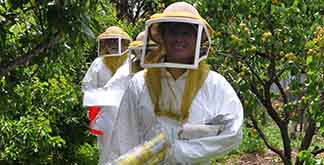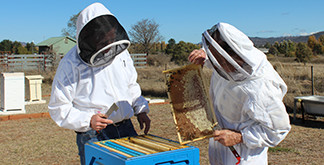

Jess Hartland, Victoria’s Bee Biosecurity Officer, on the job.
Currently Australia is free of many serious honey bee pests that damage the health of European honey bees overseas.
According to Alison Saunders, National Manager for Horticultural Cropping at Plant Health Australia, exotic pests such as varroa, tropilaelaps or tracheal mites are a constant threat.
“As bad as these pests would be, their impact will be even worse if bee pests and diseases that are already in Australia – like American or European foulbrood and small hive beetle – are not being controlled,” said Alison.
The Australian Honey Bee Industry Council (AHBIC), the peak industry body representing the interests of beekeepers in Australia, is so concerned about the threats to bees that it has developed the Australian Honey Bee Industry Biosecurity Code of Practice (the Code).
“The Code has been approved by AHBIC’s state-based beekeeping organisations and beekeepers,” said Alison.
“Even though the title suggests that it only applies to commercial beekeepers, it does in fact apply to all beekeepers in Australia.”

Regular inspections are an easy way to make sure your bees are healthy.
“The parts of the Code are there to minimise the impact of pests and diseases, and to make sure the honey bees of Australia are as healthy as they possibly can be.”
The key elements are:
“These are simple things that every beekeeper can do to help protect the health of honey bees and preserve the pollination benefits they bring.”
There are some additional parts of the code that only apply to beekeepers with more than 50 hives because of the increased risks that they pose.
The Code will be incorporated into existing industry quality assurance programs, so a beekeeper already following a program will only have to make minor changes to their hive management protocols.
“To help you to implement biosecurity measures and to ensure that you are adhering to the Code and relevant legislation, Bee Biosecurity Officers will be available in five states located within each state department of primary industries,” said Alison.
“The biosecurity officers are there to support beekeepers to comply with the Code by providing advice, training and education.”
Although governments conduct a lot of surveillance for exotic pests, beekeepers need to be on the lookout for these pests as well. Help from both hobby and commercial beekeepers is critical to the success of any surveillance activities and hive inspections are part of the Code.
“When inspecting your hives, look for the presence of exotic mites. Simple monitoring methods that every beekeeper can use to check for mites are sugar shaking, alcohol washing and drone uncapping.”
Remember that any pest that you find might not just be new to your hive, but also to the country.
The surveillance results provided by the program support trade and access to overseas markets by professional beekeepers who need to declare that a particular pest is not present in Australia to continue exporting bees and bee-related products.
If you see anything unusual on your bees call the Exotic Plant Pest Hotline on 1800 084 881.
More information about the Code of Practice is available from the pages of The Code section of this website